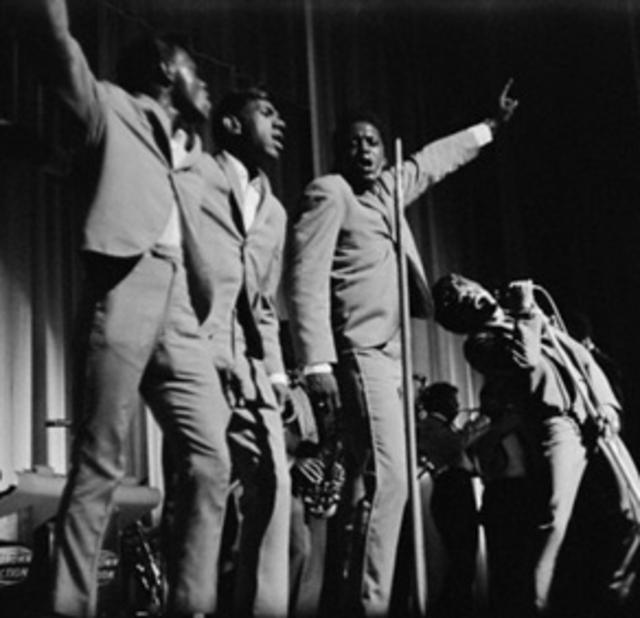The Famous Flames

Bobby Bennett (vocals; born 1938), Bobby Byrd (vocals; born August 15, 1934, died September 12, 2007), Lloyd Stallworth (vocals; born 1942, died 2001), Johnny Terry (vocals)The Famous Flames provided vocals and choreography for James Brown from their formation in 1953 until their departure in 1968. There were many comings and goings within the Famous Flames during that 15-year period. To make matters more confusing, while the Famous Flames initially referred to the entire group, it eventually came to represent only the backup vocalists, while the musicians were tagged the James Brown Band. The combination of Bobby Byrd and Johnny Terry (who joined in 1955) with later arrivals Bobby Bennett and "Baby" Lloyd Stallworth (who joined in 1959) marked the definitive lineup of the Famous Flames. Commenting on their induction into the Rock and Roll Hall of Fame in 2012, president and CEO Terry Stewart noted, "They were a group of singers, performers and dancers that created the complementary elements of one of the greatest stage shows of all time.""We were one unit, and we had a great chemistry," Bobby Bennett, the only surviving member of the Famous Flames, told the Cleveland Plain Dealer prior to their induction. "Each of us did specific things on each song, and James Brown did his thing as a member of a band.... Yes, James Brown was the most famous of the Flames, but we were all Famous Flames."Although James Brown became the undisputed leader, the Famous Flames – not to mention all the instrumentalists in Brown's band – played a significant role in his success. The Famous Flames not only sang but also were part of the frenetic choreography that made Brown's live performances so spectacular. Brown's years with the Famous Flames represents his greatest period of impact as a driving force in soul music and renown as a live performer. Brown himself, in fact, was initially one of the Flames before busting out to become the Godfather of Soul.Brown's talent was discovered by Byrd, whose baseball team played the prison squad Brown pitched for while serving a term for armed robbery in Toccoa, Georgia. Through the sponsorship of Byrd and his family, Brown was paroled in 1952. He joined Byrd's group, which sang both gospel (as the Gospel Starlighters) and rhythm & blues (as the Avons). Over time, the unstoppable Brown assumed an increasingly central role in the group. They performed around Georgia and South Carolina as the Flames (amended to the Famous Flames) in 1954 and 1955. Byrd played keyboards, Brown played drums, and they shared lead vocals. The other original members of the group were guitarist Nafloyd Scott, bassist Baroy Scott and singers Sylvester Keels, Fred Pulliam and Derek Oglesby. The latter two were replaced by Nashpendle "Nash" Knox and Johnny Terry in 1955.Late that year, the Famous Flames cut a demo of "Please Please Please" at Macon, Georgia, radio station WIBB. Their manager, Clint Brantley – who'd also managed Little Richard – circulated the recording to various labels. Leonard Chess was very interested, but Ralph Bass (of King Records) managed to sign them first. He did so over the objections of owner Syd Nathan, with whom Brown would have a somewhat contentious relationship over the years. "Please Please Please" was recut for official release at King's studio in Cincinnati. Released in March 1956, the record was credited to James Brown and the Famous Flames. Brown's top billing caused dissension within the group. "Please Please Please" was a sizable hit, reaching Number Five on Billboard's R&B chart, but two-and-a-half years would pass before another single by Brown would crack the national charts. The combination of Brown's relegation of the Famous Flames to backup band and a lack of chart success caused instability within the group, which left in April 1957. Brown assembled a new set of backup singers (with only Terry remaining from the original lineup) and musicians, including saxophonist J.C. Davis and members of his band. Byrd rejoined in 1959, soon after "Try Me" topped the R&B chart. Bobby Bennett and "Baby" Lloyd Stallworth – who'd been valets for James Brown and J.C. Davis, respectively – rounded out the Famous Flames' lineup. Onstage, the Famous Flames contributed significantly to Brown's live act. They are audible on Live at the Apollo and evident on performance footage from that time, including an unforgettably energetic segment in The T.A.M.I. Show. The latter was a multi-artist live show filmed in 1964, and Brown was the undisputed showstopper.Despite their role in his live show, Brown used the Famous Flames less frequently on record after 1964. Their final appearance on a studio recording was "Maybe the Last Time," cut in June of that year. Confusingly, the records were credited from 1955 through 1968 to James Brown and the Famous Flames – even the many on which the Famous Flames did not appear.The Famous Flames left Brown for good in 1968. Bobby Byrd, however, returned to Brown's employ after a year and a half and remained until 1973. He received a cowriting credit with Brown on such tracks as "Get Up (I Feel Like Being a) Sex Machine," "Talkin' Loud & Sayin' Nothing" and "Licking Stick – Licking Stick." Under Brown's tutelage, Byrd even charted a respectable number of R&B hits under his own name, including "Baby Baby Baby" (with Anna King), "I Need Help (I Can't Do It Alone)" and "I Know You Got Soul." For his close and lengthy working relationship with Brown, Byrd – who died in 2007 – is regarded as one of the more important auxiliary figures in the career of a major artist in music history.